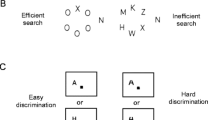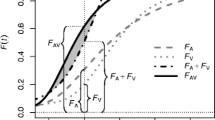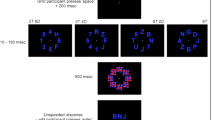Summary
A choice model for partial report from briefly exposed visual displays (Bundesen, Shibuya, & Larsen, 1985) is further investigated and related to a general class of selection models called “independent race models.” The choice model relates performance to the numbers of targets and distractors in the stimulus display by way of the choice axiom. In race models, the selection process is viewed as a race between items in the choice set toward a state of having been “processed” in that the first items reaching this state are the ones selected. If items are processed independently and processing times are exponentially distributed, selection occurs strictly in accordance with the choice axiom, so the race model is a choice model. The choice model also seems to work as a good approximation for independent race models based on other gamma distributions than the exponential one.
Similar content being viewed by others
References
Bundesen, C., Pedersen, L. F., & Larsen, A. (1984). Measuring efficiency of selection from briefly exposed visual displays: A model for partial report. Journal of Experimental Psychology: Human Perception and Performance, 10, 329–339.
Bundesen, C., Shibuya, H., & Larsen, A. (1985). Visual selection from multielement displays: A model for partial report. In M. I. Posner & O. S. M. Marin (Eds.), Attention and performance XI (pp. 631–649). Hillsdale, NJ: Erlbaum.
Clarke, F. R. (1957). Constant-ratio rule for confusion matrices in speech communication. Journal of the Acoustical Society of America, 29, 715–720.
Coltheart, M. (1972). Visual information-processing. In P. C. Dodwell (Ed.), New horizons in psychology (Vol. 2, pp. 62–85). Harmondsworth, England: Penguin Books.
Coltheart, M. (1980). Iconic memory and visible persistence. Perception & Psychophysics, 27, 183–228.
Duncan, J. (1985). Visual search and visual attention. In M. I. Posner & O. S. M. Marin (Eds.), Attention and performance XI (pp. 85–105). Hillsdale, NJ: Erlbaum.
Hoffman, J. E. (1978). Search through a sequentially presented visual display. Perception & Psychophysics, 23, 1–11.
Luce, R. D. (1959). Individual choice behavior. New York: Wiley.
Luce, R. D., Bush, R. R., & Galanter, E. (Eds.) (1963). Handbook of mathematical psychology: Vol. 1. New York: Wiley.
Luce, R. D., & Galanter, E. (1963). Discrimination. In R. D. Luce, R. R. Bush, & E. Galanter (Eds.), Handbook of mathematical psychology (Vol. 1, pp. 191–243). New York: Wiley.
Rumelhart, D. E. (1970). A multicomponent theory of the perception of briefly exposed visual displays. Journal of Mathematical Psychology, 7, 191–218.
Shaw, M. (1980). Identifying attentional and decision-making components in information processing. In R. S. Nickerson (Ed.), Attention and performance VIII (pp. 277–296). Hillsdale, NJ: Erlbaum.
Shaw, M. (1984). Division of attention among spatial locations: A fundamental difference between detection of letters and detection of luminance increments. In H. Bouma & D. G. Bouwhuis (Eds.), Attention and performance X: Control of language processes (pp. 109–121). Hillsdale, NJ: Erlbaum.
Sperling, G. (1960). The information available in brief visual presentations. Psychological Monographs, 74(11), 1–29.
Sperling, G. (1963). A model for visual memory tasks. Human Factors, 5, 19–31.
Sperling, G. (1967). Successive approximations to a model for short-term memory. Acta Psychologica, 27, 285–292.
Tanner, W. P. Jr., & Swets, J. A. (1954). A decision making theory of visual detection. Psychological Review, 61, 401–409.
Author information
Authors and Affiliations
Rights and permissions
About this article
Cite this article
Bundesen, C. Visual attention: Race models for selection from multielement displays. Psychol. Res 49, 113–121 (1987). https://doi.org/10.1007/BF00308676
Received:
Issue Date:
DOI: https://doi.org/10.1007/BF00308676




